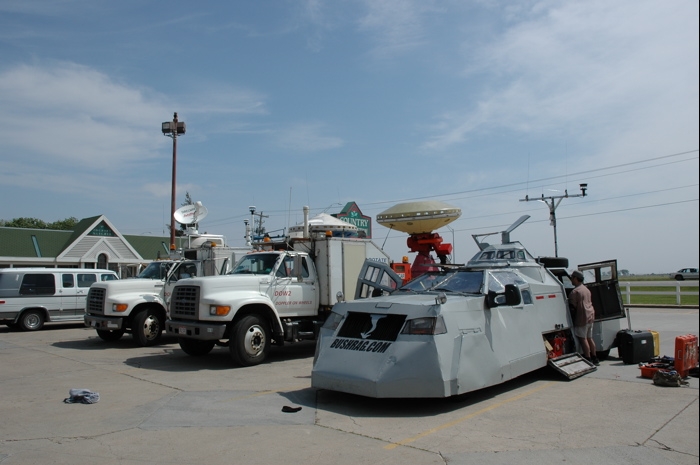Here is
what the IMAX movie photographers have to say about their Tornado Intercept
Vehicle:
The vehicle
you may have seen on the Mid-west roads this spring is a vehicle designed
to safely film tornadoes from a close distance. This vehicle has not been
designed to penetrate tornadoes only to film at close quarters. We are
in the process of producing an Imax film on tornadoes, which will be released
in 2008.
In making
the TIV, Tornado Intercept Vehicle, we took a Ford 450 super duty truck
and striped it down to the engine and chassis. Building back up, we used
1/4” steel for the flooring and tubing that makes up the inner “skeleton”.
The exterior skin is 1/8” thick steel with the side windows made of 1/2”
thick Lexan polycarbonate material. The material for the front windshields
is 1 1/4” thick Lexan. The driver compartment and the area where the cameraman
operates are double walled with another layer of 1/8” thick steel.
TIV is only
the prototype. We are testing out a number of designs before building TIV2.
I’m a firm
believer that an Imax film about tornadoes will be popular with theater
operators as well as with audiences. The power and other-worldliness of
this subject matter has a special place in the imagination of the American
public. The attraction is rooted more deeply than just a fascination with
destructive forces, but with the desire to witness something truly miraculous.
It is with these expectations that we set out to create a truly remarkable
film.
I have been
chasing tornadoes for the past five years and only now do I feel that I’m
ready to capture the fleeting moments of awe-inspiring nature that occur
in Tornado Alley. The only way to relay the true intensity of a tornado
is to be very close while filming. That is why for over the past two years
we have been developing a vehicle from which we can film near the tornado
and still be safe.
The camera
is mounted on top of the vehicle in a military-style tank turret. This
placement gives us the ability to film at all times, in any direction,
and while on the move, all essential aspects when chasing down tornadoes.
All of the
alterations done this year were the result of hard lessons the year before.
Instead of a turret we had large windows that opened on each side of the
vehicle. The design was based around simplicity, which limited us in the
directions we could shoot and during the Manchester tornado (24 June 2003)
caused us to miss some opportunities. In this case, the tornado was on
the road directly in front of us and if we could have filmed straight ahead,
as we can with the turret, then we could have driven right up to the tornado,
within a couple hundred feet. But as it was, we had to pull over to the
side of the road and stop so that the shooting port could face the tornado.
The endeavor
may seem to be risky, but with the safety precautions we are taking, I
feel confident that the chances of injury are very low.
Another
aspect of our endeavor is to equip our vehicles with instrumentation that
can record data helpful to the DOW team we are following. TIV1 has been
outfitted with a sonic anemometer, blade style anemometer, and instrumentation
that measure pressure, temperature, and humidity. It is the exact equipment
with which each of the DOW trucks has been outfitted so that our data will
be easier to synchronize with theirs.
With this
instrumentation attached to our vehicles, we will be able to test the environment
at positions close to the tornadic circulation. The DOW trucks are able
to collect data sets of the upper and mid level wind fields, but due to
the fact that they must remain roughly two to eight miles from the tornado,
they don't have the opportunity to collect measurements in the lowest 50
feet near the tornado. With our vehicles we hope to help provide those
readings and help advance the scientific understanding of tornados and
their near-environment.
Send Inquiries
to Sean@bushrag.com
their website
is: http://www.bushrag.com/
and then click on the TIV photograph on the right side of the page. |
